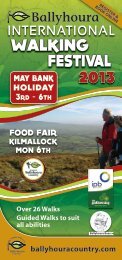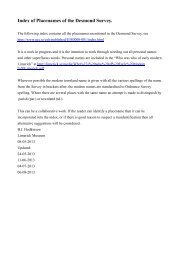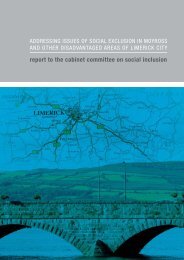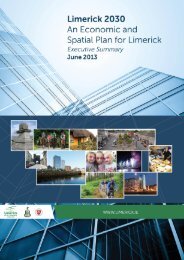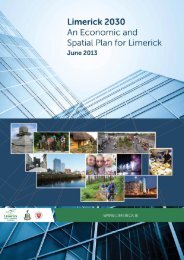An Economic and Spatial Plan for Limerick Appendices
An Economic and Spatial Plan for Limerick Appendices
An Economic and Spatial Plan for Limerick Appendices
Create successful ePaper yourself
Turn your PDF publications into a flip-book with our unique Google optimized e-Paper software.
<strong>Limerick</strong> 2030 <strong>An</strong> <strong>Economic</strong> <strong>and</strong> <strong>Spatial</strong> <strong>Plan</strong> <strong>for</strong> <strong>Limerick</strong><br />
Accessibility/Connectivity/Legibility<br />
In general terms <strong>Limerick</strong> City Centre is accessible – it is relatively close (20 minutes by car) to<br />
Shannon Airport <strong>and</strong> it has good, high quality motorway connections to Dublin <strong>and</strong> other cities<br />
<strong>and</strong> a railway station. The “Welcome” is however not as strong. The poor quality of arrival from key<br />
gateways is widespread from the lack of recognition at Shannon Airport that <strong>Limerick</strong> would be a<br />
primary point of destination, to the poor quality arrival by road (<strong>for</strong> example along Dock Road), to<br />
the arrival at Colbert Railway Station which makes no attempt to accommodate the visitor nor<br />
direct them to key places in the City Centre. This problem is exacerbated by the fact that the<br />
station is some distance (relatively) from the heart of the City Centre <strong>and</strong> there is no clear<br />
connecting route.<br />
It is essential <strong>for</strong> the success <strong>for</strong> the City Centre to address these first points of contact, creating a<br />
welcoming <strong>and</strong> appealing environment. There is also a need to rationalise traffic routes <strong>and</strong> to<br />
‘put people be<strong>for</strong>e vehicles’.<br />
Despite the Georgian legacy of a grid system of wide longitudinal streets, narrower cross streets<br />
intertwined by smaller alleys, <strong>Limerick</strong> City Centre is not as easily navigable as it should be. This is<br />
largely a reflection of the attempts to accommodate the car, especially through the<br />
implementation of a one way system, a lack of orientating spaces, a number of inappropriate<br />
planning decisions <strong>and</strong> very poor pedestrian signage.<br />
Despite the partial implementation of a public realm strategy which rightly seeks to make the City<br />
more pedestrian friendly there is need <strong>for</strong> a holistic redressing of the balance in the City Centre in<br />
favour of the pedestrian, over the car. The approach to achieving this may need to be<br />
reconsidered. This may include alternatives to substantial pedestrianisation of the City Centre. It<br />
does however mean a balanced consideration of the needs of through traffic, local traffic, public<br />
transport provision, essential servicing <strong>and</strong> first <strong>and</strong> <strong>for</strong>emost the needs of the pedestrian –<br />
resident, shopper, business person <strong>and</strong> tourist. Whilst the pedestrainised part of the City Centre has<br />
June 2013 73




